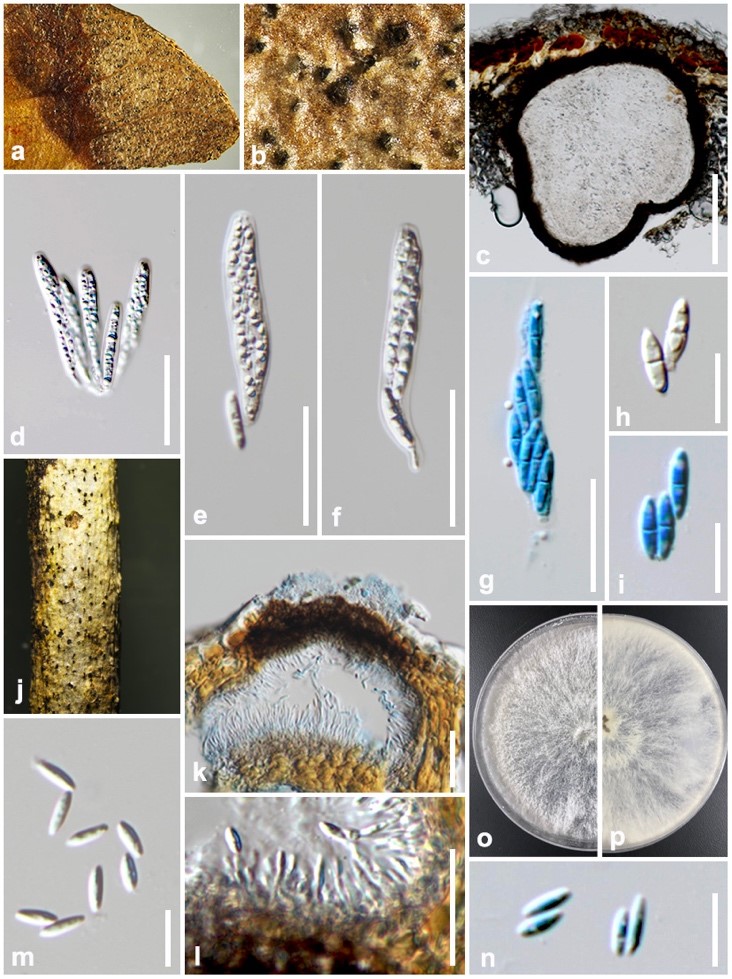Diaporthe longiascoma Y.Y. Chen, A.J. Dissanayake and Jian K. Liu sp. nov. (Figure b)
MycoBank number: MB; Index Fungorum number: IF; Facesoffungi number: FoF 12613;
Etymology: Refers to the long ascomata.
Holotype: GZAAS 19-1843
Saprobic on decaying wood. Sexual morph: Ascomata 400–500 μm diam., black, globose to irregular, clustered and scattered on dead leaves, immersed in host tissue, protruding through substrata. Asci (55–)64–71(–75) × (9–)10–15(–17) μm, 8-spored, unitunicate, sessile, elongate to clavate. Ascospores (10–)12–14(–15) × (3–)3–4(–5) μm ( = 13 × 4, n = 30), hyaline, often tetra-guttulate, with larger guttules at centre and smaller at ends, elongated to clavate. Asexual morph: Conidiomata 200–300 μm diam., globose to irregular, erumpent at maturity. Peridium up to 60–100 μm diam., parenchymatous, consisting of 5–8 layers of medium brown textura angularis. Conidiophores 15–25 × 2–2.4 μm, cylindrical, hyaline, smooth, branched, ampulliform, straight to sinuous. Conidiogenous cells up to 0.5–1 μm, phialidic, cylindrical, terminal, with slight tapering towards apex. Paraphyses 25–35 × 1–2 μm, abundant among conidiophores. Alpha conidia (6–)7–8(–9) × 2–3.5 μm ( = 7 × 3, n = 30), aseptate, hyaline, smooth, ovate to ellipsoidal, biguttulate, base subtruncate. Beta conidia (20–)25–30(–35) × (3–)3.5–4(–4.5) μm ( = 26 × 4, n = 30), aseptate, hyaline, smooth, fusiform or hooked, base subtruncate.
Culture characteristics: Colonies covering entire PDA Petri dishes after 10 d at 25 °C producing abundant white aerial mycelium. Reverse white, turning to grey in centre.
Material examined: China, Guizhou Province, Xingyi city, saprobic on decaying leaf, August 2019, Y. Y. Chen (GZAAS19-1843, holotype); ex-type living culture CGMCC = GZCC 19-0124; ibid, DuShan county, saprobic on decaying woody host, June 2020, Y. Y. Chen (GZAAS 22-0042, paratype), living culture GZCC 22-0041; ibid., GZAAS 19-1936, living culture GZCC 19-0217; ibid., GZAAS 22-0024, living culture GZCC 22-0023; ibid., GZAAS 22-0048, living culture GZCC 22-0047; ibid., GZAAS 22-0055, living culture GZCC 22-0054.
Notes: The phylogenetic results showed that six isolates of Diaporthe longiascoma clustered closer to D. spinosa forming a distinct lineage (Figure 2) with maximum support (ML/MP/BI = 100/100/1.0). Diaporthe longiascoma can be distinguished from D. spinosa in the concatenated alignment by 13/512 in ITS, 13/413 in tef, 13/453 in tub, 26/506 in cal and 12/515 in his. Morphologically, D. longiascoma differs from D. spinosa in having smaller and slightly elongated ascomata (Guo et al. 2020).

Figure b. Diaporthe longiascoma (GZAAS 19-1843, holotype). a, b Ascomata on host surface. c Section of ascomata. d–f Asci. g Asci stained in methylene blue. h Ascospores. i Ascospores stained in methylene blue. j Conidiomata on host surface. k Section of conidiomata stained in methylene blue. l Conidia attached to conidiophores. m Alpha conidia. n Alpha conidia stained in methylene blue. o 10 days old culture on PDA from above. p 10 days old culture on PDA from reverse. Scale bars: c = 200 μm; d–g = 30 μm; h, i = 10 μm; k = 100 μm, l = 30 μm; m, n = 10 μm.
